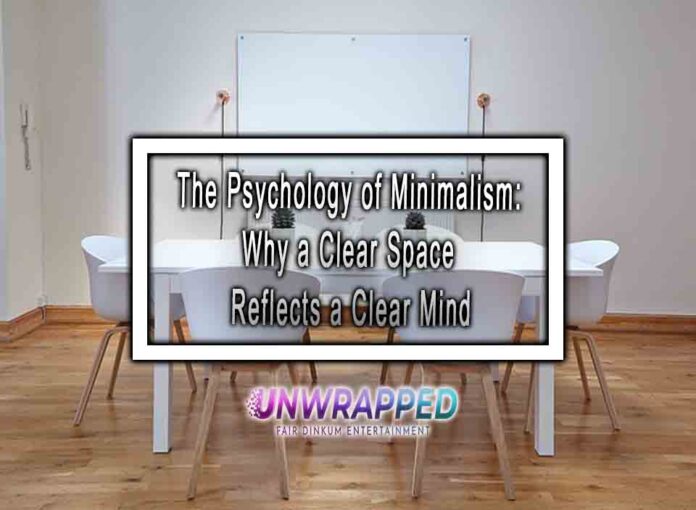In today’s fast-paced world, minimalism has emerged as more than just a design trend—it has become a lifestyle choice that resonates deeply with modern society. As people grapple with information overload, consumerism, and emotional burnout, minimalism offers a sanctuary of simplicity, reflecting a collective yearning for mental clarity and peace.
This article explores the multifaceted connection between minimalism and mental clarity, delving into its psychological, cultural, and societal implications. From the roots of the minimalist movement to its relevance in post-pandemic life, we’ll uncover why this philosophy has struck a chord with millions worldwide.
The Origins of Minimalism: A Brief Overview
Minimalism began as an artistic and cultural movement in the mid-20th century, emphasizing simplicity, functionality, and the use of minimal elements. Early pioneers in art, architecture, and design, such as Donald Judd and Ludwig Mies van der Rohe, championed the “less is more” ethos.
While initially limited to aesthetics, minimalism has since evolved into a lifestyle philosophy. Its principles—simplicity, intentionality, and the rejection of excess—resonate deeply with those seeking mental clarity and emotional balance.
The Psychological Benefits of Minimalism
- Reduced Stress and Anxiety:
- Cluttered environments often lead to cognitive overload, triggering stress.
- Simplified spaces promote focus and relaxation, fostering a sense of control over one’s surroundings.
- Enhanced Decision-Making:
- A minimalist lifestyle reduces decision fatigue by eliminating unnecessary choices.
- With fewer distractions, individuals can prioritize what truly matters.
- Boosted Creativity and Productivity:
- Minimalist environments, free of visual chaos, encourage creativity.
- Many studies highlight the correlation between clean workspaces and higher productivity.
Minimalism as a Response to Consumer Culture
The rise of minimalism can also be seen as a counter-movement to consumerism. In a society driven by material acquisition and instant gratification, minimalism challenges the notion that “more is better.” Instead, it advocates for intentional living, valuing experiences over possessions.
Key Reasons for the Shift:
- Economic Pressures: The global financial crises and rising living costs have encouraged frugality.
- Environmental Concerns: Minimalism aligns with sustainable practices, reducing waste and promoting mindful consumption.
- Digital Detox: Minimalism addresses the digital clutter that often accompanies modern life.
Cultural Reflections: Minimalism Across the Globe
Minimalism isn’t a one-size-fits-all concept; its cultural interpretations vary:
- Japanese Minimalism: Rooted in Zen philosophy, Japanese minimalism emphasizes harmony, balance, and mindfulness.
- Nordic Minimalism: Scandinavian design prioritizes functionality and warmth, reflecting a desire for hygge (coziness).
- Western Minimalism: In the U.S. and Europe, minimalism often merges with decluttering trends like Marie Kondo’s KonMari Method.
Minimalism in the Post-Pandemic Era
The COVID-19 pandemic reshaped priorities, bringing minimalism into sharper focus:
- Home as a Sanctuary: Lockdowns underscored the importance of creating calming, clutter-free living spaces.
- Mental Health Awareness: With a growing emphasis on self-care, people turned to minimalism to alleviate stress.
- Financial Prudence: Economic uncertainties prompted a shift toward mindful spending and downsizing.
Practical Ways to Embrace Minimalism
- Declutter Your Space:
- Start small: focus on one room or category, like clothing or books.
- Use the “one in, one out” rule to maintain balance.
- Digital Minimalism:
- Unsubscribe from unnecessary emails and delete unused apps.
- Limit screen time to reduce mental clutter.
- Intentional Consumption:
- Before making a purchase, ask, “Do I need this?”
- Invest in quality over quantity to minimize waste.
- Simplify Commitments:
- Learn to say no to unnecessary obligations.
- Prioritize meaningful relationships and activities.
The Intersection of Minimalism and Mental Clarity
Minimalism isn’t just about physical spaces; it’s also a mindset. By eliminating the excess—whether it’s material possessions, toxic relationships, or unnecessary tasks—people can achieve mental clarity and focus.
Key Outcomes:
- Mindfulness: Minimalism fosters present-moment awareness, aligning with practices like meditation and yoga.
- Self-Reflection: The process of decluttering often leads to deeper insights about personal values and priorities.
Critiques and Challenges of Minimalism
While minimalism has many advocates, it’s not without criticism:
- Accessibility Issues: Critics argue that minimalism sometimes caters to privileged individuals who can afford to “choose simplicity.”
- Over-Commercialization: The trend has spurred industries to sell “minimalist” products, ironically fueling consumerism.
- Cultural Appropriation: Some forms of minimalism borrow heavily from non-Western traditions without proper acknowledgment.
Conclusion
Minimalism’s rise reflects a universal longing for mental clarity in an increasingly chaotic world. By simplifying our spaces, schedules, and minds, we reclaim control over our lives and focus on what truly matters.
As society continues to evolve, minimalism serves as both a mirror and a guide, highlighting the importance of intentional living. While it may not be a perfect solution, its principles offer valuable lessons in navigating the complexities of modern life.
References
- Becker, J. (2016). The More of Less: Finding the Life You Want Under Everything You Own.
- Kondo, M. (2014). The Life-Changing Magic of Tidying Up: The Japanese Art of Decluttering and Organizing.
- Newport, C. (2019). Digital Minimalism: Choosing a Focused Life in a Noisy World.
- Various studies from the Journal of Environmental Psychology on clutter and mental health.
See Also: The Healing Power of Art: How Creativity Is Shaping Our Post-Pandemic World










